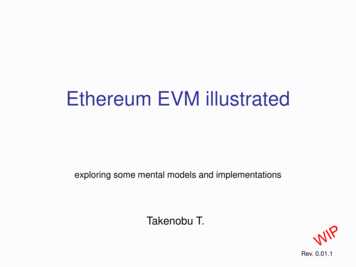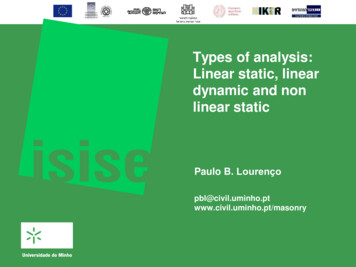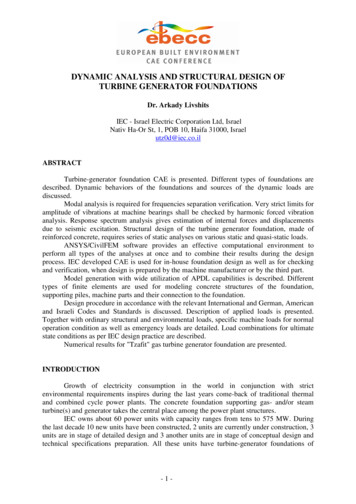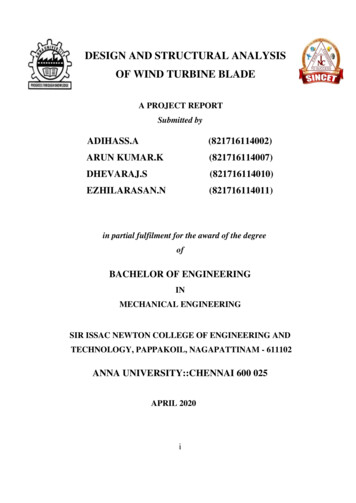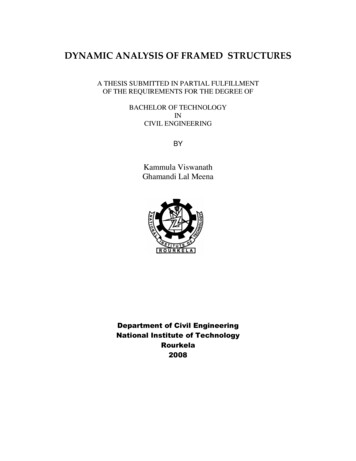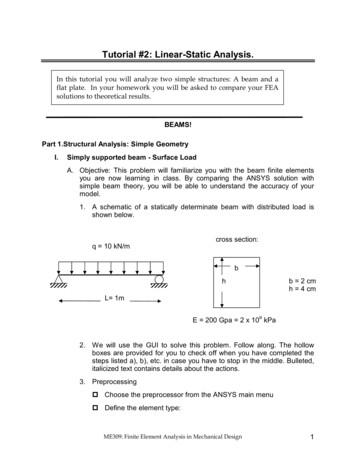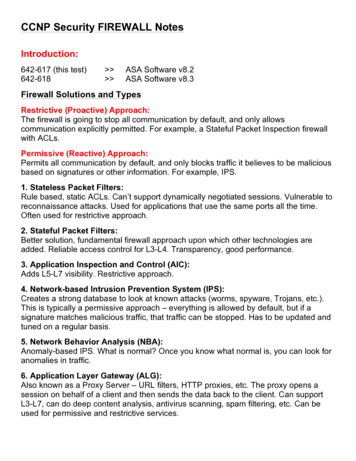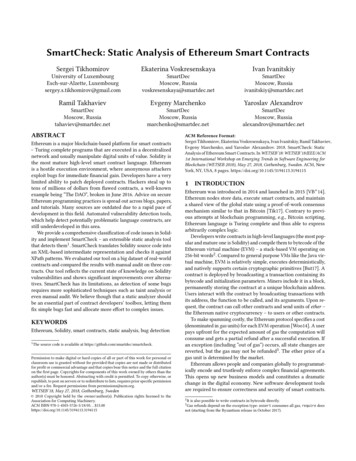
Transcription
SmartCheck: Static Analysis of Ethereum Smart ContractsSergei TikhomirovEkaterina VoskresenskayaIvan IvanitskiyUniversity of LuxembourgEsch-sur-Alzette, cow, Russiavoskresenskaya@smartdec.netSmartDecMoscow, Russiaivanitskiy@smartdec.netRamil TakhavievEvgeny MarchenkoYaroslav AlexandrovSmartDecMoscow, Russiatahaviev@smartdec.netSmartDecMoscow, Russiamarchenko@smartdec.netSmartDecMoscow, Russiaalexandrov@smartdec.netABSTRACTEthereum is a major blockchain-based platform for smart contracts– Turing complete programs that are executed in a decentralizednetwork and usually manipulate digital units of value. Solidity isthe most mature high-level smart contract language. Ethereumis a hostile execution environment, where anonymous attackersexploit bugs for immediate financial gain. Developers have a verylimited ability to patch deployed contracts. Hackers steal up totens of millions of dollars from flawed contracts, a well-knownexample being “The DAO“, broken in June 2016. Advice on secureEthereum programming practices is spread out across blogs, papers,and tutorials. Many sources are outdated due to a rapid pace ofdevelopment in this field. Automated vulnerability detection tools,which help detect potentially problematic language constructs, arestill underdeveloped in this area.We provide a comprehensive classification of code issues in Solidity and implement SmartCheck – an extensible static analysis toolthat detects them1 . SmartCheck translates Solidity source code intoan XML-based intermediate representation and checks it againstXPath patterns. We evaluated our tool on a big dataset of real-worldcontracts and compared the results with manual audit on three contracts. Our tool reflects the current state of knowledge on Solidityvulnerabilities and shows significant improvements over alternatives. SmartCheck has its limitations, as detection of some bugsrequires more sophisticated techniques such as taint analysis oreven manual audit. We believe though that a static analyzer shouldbe an essential part of contract developers’ toolbox, letting themfix simple bugs fast and allocate more effort to complex issues.KEYWORDSEthereum, Solidity, smart contracts, static analysis, bug detection1 Thesource code is available at https://github.com/smartdec/smartcheck.Permission to make digital or hard copies of all or part of this work for personal orclassroom use is granted without fee provided that copies are not made or distributedfor profit or commercial advantage and that copies bear this notice and the full citationon the first page. Copyrights for components of this work owned by others than theauthor(s) must be honored. Abstracting with credit is permitted. To copy otherwise, orrepublish, to post on servers or to redistribute to lists, requires prior specific permissionand/or a fee. Request permissions from permissions@acm.org.WETSEB’18, May 27, 2018, Gothenburg, Sweden 2018 Copyright held by the owner/author(s). Publication rights licensed to theAssociation for Computing Machinery.ACM ISBN 978-1-4503-5726-5/18/05. . . 15.00https://doi.org/10.1145/3194113.3194115ACM Reference Format:Sergei Tikhomirov, Ekaterina Voskresenskaya, Ivan Ivanitskiy, Ramil Takhaviev,Evgeny Marchenko, and Yaroslav Alexandrov. 2018. SmartCheck: StaticAnalysis of Ethereum Smart Contracts. In WETSEB’18: WETSEB’18:IEEE/ACM1st International Workshop on Emerging Trends in Software Engineering forBlockchain (WETSEB 2018), May 27, 2018, Gothenburg, Sweden. ACM, NewYork, NY, USA, 8 pages. ONEthereum was introduced in 2014 and launched in 2015 [VB 14].Ethereum nodes store data, execute smart contracts, and maintaina shared view of the global state using a proof-of-work consensusmechanism similar to that in Bitcoin [Tik17]. Contrary to previous attempts at blockchain programming, e.g., Bitcoin scripting,Ethereum language is Turing complete and thus able to expressarbitrarily complex logic.Developers write contracts in high-level languages (the most popular and mature one is Solidity) and compile them to bytecode of theEthereum virtual machine (EVM) – a stack-based VM operating on256-bit words2 . Compared to general purpose VMs like the Java virtual machine, EVM is relatively simple, executes deterministically,and natively supports certain cryptographic primitives [But17]. Acontract is deployed by broadcasting a transaction containing itsbytecode and initialization parameters. Miners include it in a block,permanently storing the contract at a unique blockchain address.Users interact with the contract by broadcasting transactions withits address, the function to be called, and its arguments. Upon request, the contract can call other contracts and send units of ether –the Ethereum native cryptocurrency – to users or other contracts.To make spamming costly, the Ethereum protocol specifies a cost(denominated in gas units) for each EVM operation [Woo14]. A userpays upfront for the expected amount of gas the computation willconsume and gets a partial refund after a successful execution. Ifan exception (including “out of gas“) occurs, all state changes arereverted, but the gas may not be refunded3 . The ether price of agas unit is determined by the market.Ethereum allows people and companies globally to programmatically encode and trustlessly enforce complex financial agreements.This opens up new business models and constitutes a dramaticchange in the digital economy. New software development toolsare required to ensure correctness and security of smart contracts.2 Itis also possible to write contracts in bytecode directly.refunds depend on the exception type: assert consumes all gas, require doesnot (starting from the Byzantium release in October 2017).3 Gas
WETSEB’18, May 27, 2018, Gothenburg, Sweden1.1S. Tikhomirov, E. Voskresenskaya, I. Ivanitskiy, R. Takhaviev, E. Marchenko, Y. AlexandrovSecurity challenges in Ethereum Security issues lead to exploits by a malicious user accountor contract; Functional issues cause the violation of the intended functionality6 ; Operational issues lead to run-time problems, e.g., bad performance; Developmental issues make code difficult to understandand improve.Security is a primary concern in Ethereum programming for multiple reasons: Unfamiliar execution environment. Ethereum differs fromcentrally managed execution environments, be that mobile,desktop, or cloud. Developers are not used to their code being executed by a global network of anonymous, mutuallydistrusting, profit-driven nodes. New software stack. The Ethereum stack (the Solidity compiler, the EVM, the consensus layer, etc) is under development, with security vulnerabilities still being discovered [Sol17b]. Very limited ability to patch contracts. A deployed contract can not be patched4 . This makes a popular “move fastand break things“ motto inapplicable: a contract must becorrect before deployment. Anonymous financially motivated attackers. Comparedto many cybercrimes, exploiting smart contracts offers highergains (the prices of cryptocurrencies have been increasingrapidly), easier cashing out (ether and tokens are instantlytradable), and lower risk of punishment due to anonymity. Rapid pace of development. Blockchain companies striveto release their products fast, often at the expense of security. Suboptimal high-level language. Some argue that Solidity itself inclines programmers towards unsafe developmentpractices [ydt16].A textbook example of an Ethereum contract exploit is the DAOhack. The DAO was an Ethereum-based venture capital fund. InMay 2016, it collected around 150 million in the largest crowdfunding campaign to date. In June 2016, an unknown hacker exploitedmultiple vulnerabilities in the DAO code and gained control overether worth around 50 million at that time [Sir16]. Though theEthereum protocol executed correctly, the core developers proposeda hard fork to restore stakeholders’ deposits, violating the premiseof decentralized applications running “exactly as programmed“5 .More recent examples of high-profile loss of ether due to softwarevulnerabilities include two incidents with the Parity multi-signaturewallet in July and November 2017 [Pal17]. These and many similarevents of a smaller scale illustrate the importance of security inEthereum.For the purposes of this paper, we assume correctness of theEthereum core infrastructure and focus on security from a contractdeveloper’s viewpoint. We classify issues in Solidity source codeand develop a static analysis tool – SmartCheck – that detects them.We test SmartCheck on a large set of real-world contracts andmeasure the relative prevalence of various code issues. SmartCheckshows significant improvements over existing alternatives in termsof false discovery rate (FDR) and false negative rate (FNR).2CLASSIFICATION OF ISSUES IN SOLIDITYCODEWe classify Solidity code issues as follows (based on [Hen17]):4 Thoughworkarounds exist, such as proxy contracts redirecting calls to an adaptableaddress of the latest version of the main contract.5 Concerns about Ethereum’s governance lead to the creation of Ethereum Classic [Eth17b] – a continuation of the Ethereum blockchain without the DAO fork.We differentiate between functional and security issues: the formerpose problems even without an adversary (though an externalmalicious actor can aggravate the situation), while the latter donot. Our primary sources are [Con16] [Sol17a] [ABC17] [DAK 15][CLLZ17] [Sol17c]. See Table 1 for a summary of all issues (thesecond column denotes severity: 3 – high, 2 – medium, 1 – low).2.1Security issues2.1.1 Balance equality. Avoid checking for strict balance equality: an adversary can forcibly send ether to any account by miningor via selfdestruct.if ( this . balance 42 ether ) { /* . */ } // badif ( this . balance 42 ether ) { /* . */ } // goodThe pattern detects comparison expressions with which contain this.balance as either left- or right-hand side.2.1.2 Unchecked external call. Expect calls to external contractto fail. When sending ether, check for the return value and handleerrors. The recommended way of doing ether transfers is transfer(see Section 2.1.4).addr . send (42 ether ) ; // badif (! addr . send (42 ether ) ) revert ; // betteraddr . transfer (42 ether ) ; // goodThe pattern detects an external function call (call, delegatecall,or send) which is not inside an if-statement.2.1.3 DoS by external contract. A conditional statement (if,for, while) should not depend on an external call: the callee maypermanently fail (throw or revert), preventing the caller fromcompleting the execution.In the following example, the caller expects the oracle to return an integer value (badOracle.answer()), but the actual oracleimplementation may throw an exception in some or all cases.function dos ( address oracleAddr ) public {badOracle Oracle ( oracleAddr ) ;if ( badOracle . answer () 42) { revert ; }// .}This rule contains multiple patterns: an if-statement with an external function call in the condition and a throw or a revert in the body; a for- or an if-statement with an external function call inthe condition.6 Thoughwithout a specification we only assume what the intended functionality is.
SmartCheck: Static Analysis of Ethereum Smart Contracts2.1.4 send instead of transfer. The recommended way to perform ether payments is addr.transfer(x), which automaticallythrows an exception if the transfer is unsuccessful, preventing theproblem described in Section 2.1.2. The pattern detects the sendkeyword.2.1.5Re-entrancy. Consider the following code:pragma solidity 0.4.19;contract Fund {mapping ( address uint ) balances ;function withdraw () public {if ( msg . sender . call . value ( balances [ msg . sender ]) () )balances [ msg . sender ] 0;}}The contract at msg.sender can get multiple refunds and retrieveall Fund’s ether by recursively calling withdraw before its shareis set to 0. Besides, it can modify the state of some third contract,which Fund depends on. Use the “checks – effects – interactions“pattern: first check the invariants, then update the internal state,then communicate with external entities (see also Section 2.1.4):function withdraw () public {uint balance balances [ msg . sender ];balances [ msg . sender ] 0;msg . sender . transfer ( balance ) ;// state reverted , balance restored if transfer fails}The pattern detects an external function call which is followedby an internal function call.2.1.6 Malicious libraries. Third-party libraries can be malicious.Avoid external dependencies or ensure that third-party code implements only the intended functionality. The pattern simply detectsthe library keyword (and thus produces some false positives).2.1.7 Using tx.origin. Contracts can call each others’ publicfunctions. tx.origin is the first account in the call chain (alwaysan externally owned one, i.e., not a contract); msg.sender is theimmediate caller. For instance, in a call chain A B C, from theC’s viewpoint, tx.origin is A, and msg.sender is B.Use msg.sender instead of tx.origin for authentication. Consider a wallet:pragma solidity 0.4.19;contract TxWallet {address private owner ;function TxWallet () { owner msg . sender ; }function transferTo ( address dest , uint amount ) public{require ( tx . origin owner ) ; // authenticationdest . transfer ( amount ) ;}}User sends ether to the address of the TxAttackerWallet, whichforwards the call to a TxWallet and obtains all funds, acting as theuser (tx.origin):pragma solidity 0.4.19;interface TxWallet {function transferTo ( address dest , uint amount ) ;}contract TxAttackerWallet {address private owner ;function TxAttackerWallet () { owner msg . sender ; }WETSEB’18, May 27, 2018, Gothenburg, Swedenfunction () payable {TxWallet ( msg . sender ) . transferTo ( owner , msg . sender. balance ) ;}}The pattern detects the environmental variable tx.origin.2.1.8 Transfer forwards all gas. Solidity provides many ways totransfer ether (see Section 2.1.4). addr.call.value(x)() transfersx ether and forwards all gas to addr, potentially leading to vulnerabilities like re-entrancy (see Section 2.1.5). The recommended wayto transfer ether is addr.transfer(x), which only provides thecallee with a “stipend“ of 2300 gas. The pattern detects functionswhose name is call.value and whose argument list is empty.2.2Functional issues2.2.1 Integer division. Solidity supports neither floating-pointnor decimal types. For integer division, the quotient is roundeddown. Account for it, especially when calculating ether or tokenamounts. The pattern detects division (/) where the the numeratorand the denominator are number literals.2.2.2 Locked money. Contracts programmed to receive ethershould implement a way to withdraw it, i.e., call transfer (recommended), send, or call.value at least once. The patterns detectscontracts that contain a payable function but contain neither ofthe withdraw-enabling functions mentioned above.2.2.3 Unchecked math. Solidity is prone to integer over- andunderflow7 . Overflow leads to unexpected effects and can lead toloss of funds if exploited by a malicious account. Use the SafeMathlibrary8 that checks for overflows (multiple implementations exist,e.g. [Saf17]). The pattern detects arithmetic operations , -, *, whichare not inside a conditional statement. This rule was temporarilymuted for testing (Section 4) due to a high false positive rate.2.2.4 Timestamp dependence. Miners can manipulate environmental variables and are likely to do so if they can profit from it.Consider a lottery that distributes prizes depending on whethernow (alias for block.timestamp) is odd or even:if ( now % 2 0) winner pl1 ; else winner pl2 ;A miner can tweak the timestamp and gain unfair advantage.Use block numbers and average time between blocks to estimatethe current time. Use secure sources of randomness, such as RANDAO [Ran17]. The pattern detects the environmental variable now.2.2.5 Unsafe type inference. Solidity supports type inference:the type of i in var i 42; is the smallest integer type sufficientto store the right-hand side value (uint8). Consider a for-loop:for ( var i 0; i array . length ; i ) { /* . */ }The type of i is inferred to uint8. If array.length is biggerthan 256, an overflow will occur. Explicitly define the type whendeclaring integer variables:for ( uint256 i 0; i array . length ; i ) { /* . */ }The pattern detects assignments where the left-hand side is avar and the right-hand side is an integer (matches ˆ[0-9] ).7 Referred8 Seeto as simply overflow for brevity.Section 2.1.6 for advice on library usage.
WETSEB’18, May 27, 2018, Gothenburg, Sweden2.3S. Tikhomirov, E. Voskresenskaya, I. Ivanitskiy, R. Takhaviev, E. Marchenko, Y. AlexandrovOperational issues2.3.1 Byte array. Use bytes instead of byte[] for lower gasconsumption. The pattern detects the construction byte[].2.3.2 Costly loop. Ethereum is a very resource-constrained environment. Prices per computational step are orders of magnitudehigher than with centralized cloud providers. Moreover, Ethereumminers impose a limit on the total number of gas consumed in ablock. In the following example, if array.length is large enough,the function exceeds the block gas limit, and transactions calling itwill never be confirmed:for ( uint256 i 0; i array . length ; i ) { costlyF () ; }This becomes a security issue, if an external actor influencesarray.length. E.g., if array enumerates all registered addresses,and registration is open, an adversary can register many addresses,causing denial of service. The rule includes two patterns: a for-statement with a function call or an identifier insidethe condition; a while-statement with a function call inside the condition.2.4Developmental issues2.4.1 Token API violation. ERC20 is the de-facto standard APIfor implementing tokens – transferable units of value managed bya contract. Exchanges and other third-party services may struggleto integrate a token that does not conform to it. Certain ERC20functions (approve, transfer, transferFrom) return a bool indicating whether the operation succeded. It is not recommended tothrow exceptions (revert, throw, require, assert) inside thosefunctions. Note that library functions may also throw exceptions(see Section 2.1.6).function transferFrom ( address spender , uint value )returns ( bool success ) {require ( value 20 wei ) ;// .}The pattern detects a contract inherited from a contract witha name including the word “token“, which may throw exceptionsfrom inside one of the functions mentioned above.2.4.2 Compiler version not fixed. Solidity source files indicatethe versions of the compiler they can be compiled with:pragma solidity 0.4.19;pragma solidity 0.4.19;// bad : 0.4.19 and above// good : 0.4.19 onlyIt is recommended to follow the latter example, as future compilerversions may handle certain language constructions in a way thedeveloper did not foresee. The pattern detects the version operator ˆin the pragma directive.2.4.3 private modifier. Contrary to a popular misconception,the private modifier does not make a variable invisible. Minershave access to all contracts’ code and data. Developers must account for the lack of privacy in Ethereum. The pattern detects statevariable declarations with a private modifier.2.4.4 Redundant fallback function. Contracts should reject unexpected payments (see Sections 2.1.1, 2.2.2). Before Solidity 0.4.0,it was done manually:function () payable { throw ; }Starting from Solidity 0.4.0, contracts without a fallback functionautomatically revert payments, making the code above redundant.The pattern detects the described construction (only if the pragmadirective indicates the compiler version not lower than 0.4.0).2.4.5 Style guide violation. In Solidity, function9 and event namesusually start with a lower- and uppercase letter respectively:function Foo () ;event logFoo () ;function foo () ;event LogFoo () ;////////badbadgoodgoodViolating the style guide decreases readability and leads to confusion. The pattern detects the described constructions.2.4.6 Implicit visibility level. The default function visibility levelin Solidity is public. Explicitly define function visibility to preventconfusion.function foo () { /* . */ } // badfunction foo () public { /* . */ } // goodfunction bar () private { /* . */ } // goodThe pattern detects function and variable definitions without avisibility modifier.3AUTOMATED ANALYSIS OF SMARTCONTRACTS3.1 Approaches to code analysisDynamic code analysis runs the program and considers only asubset of all execution paths on some input data [LSCL12]. Staticcode analysis may guarantee full coverage without executing theprogram and may run fast enough on code of reasonable size. Staticanalysis usually includes three stages:(1) building an intermediate representation (IR), such as abstractsyntax tree or three-address code, for a deeper analysis compared to analyzing text;(2) enriching the IR with additional information [Wög05] using algorithms such as control- and dataflow analysis (synonym, constant, and type propagation [ASU07]), taint analysis [TPF 09], symbolic execution, abstract interpretation;(3) vulnerability detection w.r.t. a database of patterns, whichdefine vulnerability criteria in IR terms.In this paper, we do not consider formal verification methods, asthey require a rarely available formal specification of the contract’sintended functionality.3.2SmartCheckWe propose SmartCheck – a static analysis tool for Ethereum smartcontracts implemented in Java. SmartCheck runs lexical and syntactical analysis on Solidity source code. It uses ANTLR [ant17] anda custom Solidity grammar to generate an XML parse tree [ASU07]as an intermediate representation (IR). We detected vulnerabilitypatterns by using XPath [xpa] queries on the IR. Thus SmartCheckprovides full coverage: the analyzed code is fully translated to theIR, and all its elements can be reached with XPath matching. Linenumbers are stored as XML attributes and help localize findings in9 Withthe exception of constructors: they must share the name with the contract andthus usually start with an uppercase letter.
SmartCheck: Static Analysis of Ethereum Smart ContractsTable 1: Code issues detected by SmartCheck(gray background – false positives possible)NameS.Balance equal- 2ity (2.1.1)Unchecked ex- 3ternal call (2.1.2)DoS by external 3contract (2.1.3)send instead of 2transfer (2.1.4)Reentrancy (2.1.5)Maliciouslibraries (2.1.6)31Using2tx.origin (2.1.7)Transferfor- 3wardsallgas (2.1.8)Integerdivi- 1sion (2.2.1)Locked2money (2.2.2)Uncheckedmath (2.2.3)Timestamp dependence (2.2.4)Unsafe type inference (2.2.5)Byte array (2.3.1)Costlyloop (2.3.2)12212Token API viola- 1tion (2.4.1)Compiler1versionnotfixed (2.4.2)private modi- 1fier (2.4.3)Redundant1fallback function (2.4.4)Style guide viola- 1tion (2.4.5)Implicit visibil- 1ity level (2.4.6)DescriptionAdversary can manipulate contract logicby forcibly sending it ether. Use non-strictinequality on balancesThe return value is not checked. Alwayscheck return values of functionsExpect external calls to deliberately throwWETSEB’18, May 27, 2018, Gothenburg, SwedenFigure 1: Parse tree for the Balance equality code exampleifStatementThe private modifier does not hide thevariable’s value, only prevents external contracts from editing itThe payment rejection fallback is redundant. Remove the function to save space:payments are rejected automaticallyUnfamiliar capitalization style causes confusion. Start function names with lowercase, events with uppercaseFunctions are public by default. Avoid ambiguity: explicitly declare visibility level{ .expressionexpressionThe return value of send should bechecked. Use transfer, which is equivalent to if (!send()) throw;External contracts should be called after alllocal state updatesUsing external libraries may be dangerous.Avoid external code dependencies, audit allcode that is part of the projectA malicious contract can act on a user’sbehalf. Use msg.sender for authenticationa.call.value()() forwards all gas, allowing the callee to call back. Usea.transfer(): it only provides the calleewith 2300 gas (insufficient for a callback)The quotient is rounded down. Account forit, especially for ether and token amountsThe contract receives ether, but there is noway to withdraw it. Implement a withdrawfunction or reject paymentsWithout extra checks, integer over- andunderflow is possible. Use SafeMathMiners can alter timestamps. Make criticalcode independent of the environmentType inference choses the smallest integertype possible. Explicitly specify typesbyte[] requires more than bytesExpensive computation inside loops mayexceed the block gas limit. Avoid loops withbig or unknown number of stepsThe contract throws where the ERC20 standard expects a bool. Return false insteadContract compiles with future compiler versions. Specify the exact compiler versionblockifConditionifenvVarDefthis.balance 2source code. IR attributes can be enriched with additional information when new analysis methods are implemented. The tool canbe extended to support other smart contact languages by addingan ANTLR grammar and a pattern database (IR-level algorithmsremain unchanged).As an example, consider the Balance equality issue (2.1.1). We aimto detect constructions that test the contract’s balance for equality,for instance:if ( this . balance 42 ether ) {.}.The parse tree of this construction is shown in Figure 1.The corresponding XPath pattern is shown in Listing 1.// expression [ expression // envVarDef[ matches ( text () [1] , " this . balance " ) ]][ matches ( text () [1] , " ! " ) ]Listing 1: XPath pattern for the Balance equality issueIn this case we do not expect false positives, as we are able toprecisely describe the target construction in XPath10 .More complex rules can not be precisely described with XPath,which leads to false positives. Consider the Re-entrancy issue (2.1.5).SmartCheck reports violations of the Checks-Effects-Interactions(CEI) pattern, which does not always lead to re-entrancy (Listing 2).pragma solidity 0.4.19;contract Foo {bool inBar false ;function bar ( address someAddress ) {if ( inBar ) throw ;inBar true ;someAddress . transfer (0) ;inBar false ;}}Listing 2: Violation of CEI not leading to re-entrancy10 Assumingthat ANTLR builds the AST correctly based on the Solidity grammar.
WETSEB’18, May 27, 2018, Gothenburg, SwedenS. Tikhomirov, E. Voskresenskaya, I. Ivanitskiy, R. Takhaviev, E. Marchenko, Y. Alexandrov4 EXPERIMENTAL RESULTS4.1 Goals and definitionsWe compare SmartCheck with three freely available tools aimed atstatically detecting vulnerabilities in Ethereum contracts: Oyente,Remix, and Securify11 and with the results of manual audit.We define a true finding as an issue (detected by a tool withmanual verification or manually) that is a bad practice and shouldbe fixed from our viewpoint (it may or may not be an exploitablevulnerability). All issues found by the tools were manually labeled aseither true positive (TP) or false positive (FP). A false negative (FN)for each of the four tools (Oyente, Remix, Securify, and SmartCheck)is a true finding that was not detected by this tool.For each tool, the false discovery rate (FDR) is the number of FPsfor this tool divided by the number of all issues reported by thistool: FDR FP / (TP FP). False negative rate (FNR) is the numberof FNs for this tool divided by the number of all true findings (foundby any of the tools or manually), which is the sum of TP and FNfor this tool: FNR FN / (TP FN).Section 4.2 assesses FDR and FNR of SmartCheck and three othertools on three typical contracts. Section 4.3 measures the prevalenceof code issues on a large set of real-world contracts.and block the normal operation of the contract. A public function(i.e., such that any Ethereum user can call it) allowed to add anelement to an internal array (Listing 3). Several critical functionsthen iterated through this array (e.g., Listing 4), so an attackercould make those functions permanently fail (a function call wouldrequire more gas than the block gas limit).function createGroup ( string name , uint goal )onlyOpenAuctionreturns ( uint8 err , uint groupIndex ){if ( checkDeadline () false && goal fundingGoal &&goal invoiceAmount ) {groupIndex groups . length ;groups [ groupIndex ]. groupIndex groupIndex ;groups [ groupIndex ]. name name ;groups [ groupIndex ]. goal goal ;EventGroupCreated ( groupIndex , name , goal );return (0 , groupIndex ) ;} else {return (1 , 0) ;}}Listing 3: Adding an element to the internal array4.2Case studiesWe consider three contracts: Genesis (“the platform for the private trust management market“ [Gen17a], source code [Gen17b],analyzed at commit 1ecf99d), Hive (“the first crypto currencyinvoice financing platform“ [Hiv17a], source code [Hiv17b], analyzed at commit 0d54699), and Populous (“an online platformthat matchmakes invoice sellers to invoice buyers hosted on theblockchain“ [Pop17a], source code [Pop17b], analyzed at commit10de4ae).The FDR and FNR for each tool (in % and in absolute numbers)are presented in Table 2.Oyente and Securify did not show any TPs on these threee contracts. Remix detected TPs only in the Populous contract. Remix andSmartCheck showed an overall FDR of 97% and 69% respectively,and an overall FNR of 92% and 47% respectively. This means thatSmartCheck showed better FDR and FNR compared to its closestcompetitor. Overall, SmartCheck reported 87 issues in the threecontracts.Requirements for code analysis tools differ across platforms anddomains. Due to a peculiar security landscape in smart contractprogramming (see Section 1.1), low FN rate is crucial (a missedvulnerabili
Ethereum was introduced in 2014 and launched in 2015 [VB 14]. Ethereum nodes store data, execute smart contracts, and maintain a shared view of the global state using a proof-of-work consensus mechanism similar to that in Bitcoin [Tik17]. Contrary to previ-ous attempts at blockchain programming, e.g., Bitcoin scripting,


